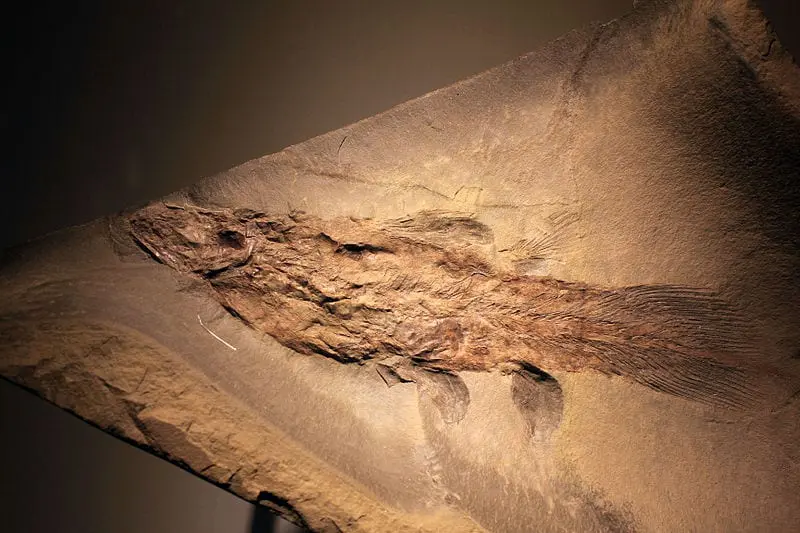Evolutionists often appeal to the fossil record for absolute proof of their ideas about Earth’s history. But what does the fossil record really reveal about the origin and history of life? In this four part series we will examine the observational evidence from the fossil record and will see that the evidence confirms the Bible’s account of history, not man’s ideas about the past.
There are two different views of the fossil record. The dominate view throughout history, until the last few centuries, is that the global Flood described in Genesis 6-9 was responsible for laying down most of the rock layers and burying the organisms that would become fossils. According to the Bible, this Flood happened only about 4,300 years ago so the fossil record is only a few thousand years old. If this view is true, then we should find billions of dead things rapidly buried by water all over the world. Since the Bible clearly states that each kind was created fully formed and functioning and only able to reproduce within the confines of “kind”, we should expect only fully formed and functioning creatures to be found in the fossil record.
The other view of the fossil record is that it is a record of an ancient history of Earth’s past. According to the evolutionary view, the rock layers were laid down slowly over millions of years. They preserve a record of the slow, gradual development of life as it progressed from simple to complex. If this view is true, we should find a record littered with transitional forms (missing links) and simple forms of life. But do we find evidence of slow, gradual change in the fossil record or is it the remnant of a watery cataclysm in Earth’s recent past?
Over the past century fossils known as “living fossils” or “lazarus taxa” are continually popping up all over the world. Living fossils are defined as “an organism…that has remained essentially unchanged from earlier geologic times and whose close relatives are usually extinct.” These fossils defy evolutionary expectations of Earth’s past. According to evolution, life is constantly changing so living fossils (creatures that have existed for millions of years unchanged) should be relatively rare if any exist at all. But living fossils have been found for nearly every major family group.
Here are just a few examples out of many:
Perhaps the most famous example is the coelacanth. Until 1938 scientists thought that coelacanths, which are present in rock layers supposedly dating at 350 million years old, went extinct some 65-70 million years ago. But in 1938 a fisherman in Madagascar pulled one up onto his fishing boat! This coelacanth was virtually identical to the fossilized remains of supposedly 350 million year old coelacanths. In 350 million years no evolution had occurred! The living fish matched the fossil fish.
Another well-known example is the Wollemi pine tree. This tree supposedly went extinct with the dinosaurs some 65 million years ago. Yet, in 1994, a park ranger in eastern Australia found a living stand of Wollemi pine trees. You can now buy these trees and plant them in your yard! The living Wollemi pines are virtually indistinguishable from fossil Wollemi pines. 65 million years of no change!
On the island nation of Japan, as well as in China, live giant salamanders that can reach lengths of 5.5 feet (1.7 m)! These salamanders are found in strata that is supposedly 30 million years old and yet the fossils look identical to the living salamanders. In 30 million years, no evolution has occurred.
Last year (2014) scientists discovered mushroom-looking creatures off of the coast of Australia and compared these creatures to similar ones previously known only from the fossil record. Supposedly, based on the conventional dating of the rock layer they are found in, these creatures have lived on earth for 550 million years. Yet the living creatures look just like the fossilized ones. 550 million years of absolutely no evolution.
These are just a handful of examples out of many. Other examples include creatures you are probably familiar with such as crabs, lobsters, squirrels, dragonflies, spiders, ferns, wasps and more!
The fossil record does not support the notion of evolution over millions of years. Instead, the fossil record supports the Bible’s history. Based on the Bible, we can easily explain living fossils. The Flood buried billions of creatures in sediment but two representatives of every kind (about the level of family in our modern taxonomic scheme) were preserved aboard the Ark. After the Flood, the environment was radically different. Some creatures were able to adapt to these new environments and so we still have them today (like squirrels and wasps). Others were not able to cope and died out (like dinosaurs and trilobites). The evidence supports the Bible’s account of history, not man’s ideas about the past. We can trust the Bible’s history and it’s message of salvation through our Creator, Jesus Christ.






